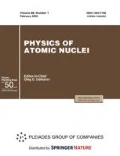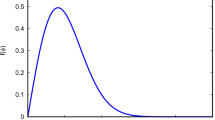Abstract
The main obstacle in attempts to construct a consistent quantum gravity is the absence of independent flat time. This can in principle be cured by going out to higher dimensions. The modern paradigm assumes that the fundamental theory of everything is some form of string theory living in space of more than four dimensions. We advocate another possibility that the fundamental theory is a form of D=4 higher derivative gravity. This class of theories has a nice feature of renormalizability, so that perturbative calculations are feasible. There are also finite N=4 supersymmetric conformal supergravity theories. This possibility is particularly attractive. Einstein's gravity is obtained in a natural way as an effective low-energy theory. The N=1 supersymmetric version of the theory has a natural higher dimensional interpretation due to V.I. Ogievetsky and E.S. Sokatchev, which involves embedding our curved Minkowski spacetime manifold into flat eight-dimensional space. Assuming that a variant of the finite N=4 theory also admits a similar interpretation, this may eventually allow one to construct consistent quantum theory of gravity. We argue, however, that, even though future gravity theory will probably use higher dimensions as construction scaffolds, its physical content and meaning should refer to four dimensions, where an observer lives.
Similar content being viewed by others
References
C. J. Isham, in Proc. of GIFT International Seminar on Theoretical Physics, Salamanca, 1992; gr-qc/9210011.
R. Arnowitt, S. Deser, and C. Misner, Phys. Rev. 117, 1595 (1960).
R. Penrose, Riv. Nuovo Cimento 1, 252 (1969).
T. Harada, Prog. Theor. Phys. 107, 449 (2002).
K. Gödel, Rev. Mod. Phys. 21, 447 (1949); C. W. Misner and A. H. Taub, Zh. Éksp. Teor. Fiz. 28, 233 (1969) [Sov. Phys. JETP 28, 122 (1969)]; M. Visser, Lorentzian Wormholes: from Einstein to Hawking (AIP, NewYork, 1995).
A. Carlini and I. D. Novikov, Int. J. Phys. D 5, 445 (1996).
S. Hawking, Commun. Math. Phys. 87, 395 (1982).
J. Wheeler, Relativity, Groups, and Topology, Ed. by C. DeWitt and B. DeWitt (Gordon and Breach, New York, 1964), p. 316; B. DeWitt, Phys. Rev. 160, 1113 (1967).
E. D'Hoker and D. H. Phong, Phys. Lett. B 529, 241 (2002); Nucl. Phys. B 636, 3, 61 (2002); 639, 129 (2002).
G. S. Danilov, hep-th/0112022.
E. S. Fradkin and A. A. Tseytlin, Phys. Rep. 119, 233 (1985), and references therein.
A. D. Sakharov, Dokl. Akad. Nauk SSSR 12 (11), 70 (1968) [Sov. Phys. Dokl. 12, 1040 (1968)].
A. V. Smilga, in Proc. of the Int. Symp. on Group Theoretical Methods in Physics, Zvenigorod, 1982, Vol. 2, p. 73.
T. Eguchi and A. J. Hanson, Ann. Phys. (N.Y.) 120, 82 (1979).
A. V. Smilga, Nucl. Phys. B 234, 402 (1984).
T. D. Lee and G. C. Wick, Nucl. Phys. B 9, 209 (1969); Phys. Rev. D 2, 1033 (1970).
I. Antoniadis and E. T. Tomboulis, Phys. Rev. D 33, 2756 (1986).
V. I. Ogievetsky and E. S. Sokatchev, Yad. Fiz. 31, 264 (1980) [Sov. J. Nucl. Phys. 31, 140 (1980)]; Yad. Fiz. 31, 821 (1980) [Sov. J. Nucl. Phys. 31, 424 (1980)]; Sov. J. Nucl. Phys. 32, 589 (1980); Sov. J. Nucl. Phys. 32, 870 (1980).
P. van Nieuwenhuizen, Phys. Rep. 68, 189 (1981), and references therein.
V. Guillemin and A. Pollack, Differential Topology (Prentice Hall, Englewood Cliffs (NJ), 1974).
D. R. Hofstadter, Gödel, Escher, Bach: an Eternal Golden Braid (Basic Books, 1979).
J. M. Maldacena, Adv. Theor. Math. Phys. 2, 231 (1998); S. S. Gubser, I. R. Klebanov, and A. M. Polyakov, Phys. Lett. B 428, 105 (1998).
Author information
Authors and Affiliations
Additional information
From Yadernaya Fizika, Vol. 66, No. 11, 2003, pp. 2141–2151.
Original English Text Copyright © 2003 by Smilga.
This article was submitted by the author in English.
On leave of absence from ITEP, Moscow, Russia
Rights and permissions
About this article
Cite this article
Smilga, A.V. Quantum gravity as Escher's Dragon. Phys. Atom. Nuclei 66, 2092–2102 (2003). https://doi.org/10.1134/1.1625752
Received:
Issue Date:
DOI: https://doi.org/10.1134/1.1625752




